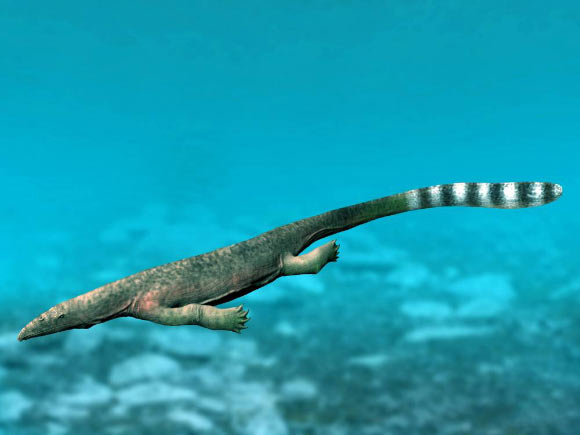Pachystropheus rhaeticus — one of the last thalattosaur, a large sea-lizard that behaved like an otter — was able to move on land, but was most likely a primarily marine predator with an ecological niche distinct from coeval marine reptiles (placodonts, ichthyosaurs) and carnivorous fishes (hybodont sharks, actinopterygians).

Life restoration of Thalattosaurus alexandrae. Image credit: Nobu Tamura, http://spinops.blogspot.ca.
Pachystropheus rhaeticus is a species of thalattosaur from in the Late Triassic deposits of Britain and continental Europe.
Although known for a long time, this ancient reptile remains an enigma.
For years it was assumed Pachystropheus rhaeticus was one of the first choristoderes, another group of crocodile-like marine reptiles.
In a new study, University of Bristol paleontologist Jacob Quinn and his colleagues examined the original name-bearing specimen of Pachystropheus rhaeticus from 1935.
They compared this to a remarkable new specimen of Pachystropheus, known as Annie, that contains hundreds of bones from several individuals.
“Thalattosaurs existed throughout the Triassic. Some of them reached 4 m (13 feet) in length and would have been the terrors of the seas,” Quinn said.
“But our Pachystropheus rhaeticus was only 1 m (3.3 feet) long, and half of that was its long tail.”
“It had a long neck too, a small head the size of a matchbox, which we haven’t found, and four paddles.”
“If it was like its relatives, it would have had lots of sharp little teeth, ideal for snatching fish and other small, wriggly prey.”
“Previously Pachystropheus rhaeticus had been identified as the first of the choristoderes, another group of crocodile-like marine reptiles, and it was treated as very important because it was the oldest,” said University of Bristol’s Professor Mike Benton.
“Jacob was able to show that some of the bones actually came from fishes, and the others that really belonged to Pachystropheus rhaeticus show it was actually a small thalattosaur.”
“So, from being regarded as the first of the choristoderes, it’s now identified as the last of the thalattosaurs.”
“Pachystropheus rhaeticus probably lived the life of a modern-day otter, eating small fish or invertebrates such as shrimps,” said Dr. David Whiteside,
“These slender reptiles had long necks, a tail flattened for swimming, and remarkably robust forelimbs for a marine animal, which suggests Pachystropheus rhaeticus may have come onto land to feed or to avoid predators.”
“At the time, the Bristol area, and indeed much of Europe, was shallow seas, and these animals may have lived in a large colony in the warm, shallow waters surrounding the island archipelago.”
The results appear in the Journal of Vertebrate Paleontology.
_____
Jacob G. Quinn et al. The relationships and paleoecology of Pachystropheus rhaeticus, an enigmatic latest Triassic marine reptile (Diapsida: Thalattosauria). Journal of Vertebrate Paleontology, published online June 4, 2024; doi: 10.1080/02724634.2024.2350408

